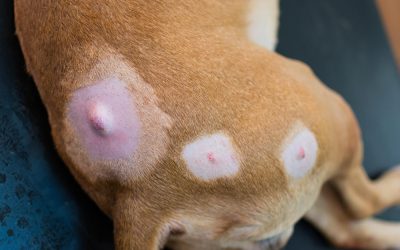Skin Tags on Dogs: Causes, Symptoms & Treatment

Skin tags, also called acrochordons or fibroepithelial polyps, are benign growths that protrude from the skin’s surface. A thin stalk or peduncle typically attaches these fleshy outgrowths to the body. While they may vary in size, color, and texture, skin tags are generally small, soft, and movable.
Skin tags might seem harmless, but understanding their causes and managing their appearance can help keep your dog comfortable. Let’s explore everything you need to know to handle skin tags on dogs effectively.
Causes Of Skin Tags On Dogs
The exact causes of skin tags in dogs are not always clear, but several factors may contribute to their formation:
- Friction or irritation: Constant rubbing or friction against the skin, such as from collars, harnesses, or bedding, can lead to the development of skin tags.
- Genetics: Some breeds, like Boxers, English Bulldogs, Cocker Spaniels, Poodles, and Miniature Schnauzers, may have a genetic predisposition to developing skin tags.
- Hormonal imbalances: Fluctuations in hormones, particularly during pregnancy or certain medical conditions, can trigger the growth of skin tags.
- Papillomavirus: known for causing warts in dogs, but it can also occasionally cause skin tags.
- Obesity: Excess weight can increase skin folds and friction, creating an environment conducive to the formation of skin tags.
Common Locations For Skin Tags On Dogs
Skin tags can appear almost anywhere on a dog’s body, but they are most commonly found in areas prone to friction or skin folds, such as:
- Neck (from collars or harnesses)
- Armpits
- Groin area
- Belly (especially in overweight dogs)
- Eyelids
- Ears
- Between the toes
Symptoms of Skin Tags in Dogs
In most cases, skin tags on dogs are asymptomatic and pose no significant health risks. However, you should be aware of the following potential symptoms:
- Bleeding or oozing: If a skin tag becomes irritated or traumatized, it may bleed or ooze fluid.
- Inflammation or redness: Skin tags can become inflamed or irritated, leading to redness and swelling around the base.
- Discomfort or pain: While rare, some skin tags may cause discomfort or pain if they are located in sensitive areas or become caught on objects.
Are Skin Tags On Dogs Dangerous?
Dr. Jason Gagné, DVM, DACVIM, says: “Generally, no urgent action is required if you detect skin tags on your dog. They’re primarily a cosmetic condition and don’t pose a health threat. Unlike warts, they’re not contagious to other dogs, and you will not contract them.
It’s a good idea to take a picture of them occasionally to track their shape, size, and color. If your pet seems to favor areas of their body without the skin tag, this could be a sign that it bothers them.
Also, if skin tags become irritated or are concerned about them, talk to your veterinarian. “
Identifying Skin Tags On Dogs – Characteristics And Appearance
Skin tags on dogs can vary in appearance, but they typically share the following characteristics:
- Small, fleshy growths
- Attached to the skin by a thin stalk or peduncle
- Movable and can range in color from flesh-toned to darker shades
- Soft and pliable to the touch
- May appear smooth, wrinkled, or irregular in shape
Differentiating Skin Tags From Other Skin Growths On Dogs – Warts, Moles, Etc.
While skin tags are common and typically benign, it’s crucial to differentiate them from other types of skin growths that may require medical attention. Here are some key differences to look for:
- Warts: Unlike skin tags, warts are caused by viral infections and often appear as rough, cauliflower-like growths. They may be raised, discolored, and have a crusty or irregular surface.
- Moles: Moles are pigmented growths that can be flat or raised and may have an irregular shape or color. Unlike skin tags, moles are typically not attached by a stalk and are firmly embedded in the skin.
- Lipomas: Lipomas are soft, movable masses composed of fatty tissue. They often feel like a round or oval lump under the skin and are not attached by stalk-like skin tags.
- Tumors: Tumors can vary in appearance, but they are typically firm, fixed masses that may grow rapidly and have an irregular shape or texture. Unlike skin tags, tumors are not attached by a stalk and may be accompanied by other symptoms, such as pain or bleeding.
Diagnosing Skin Tags On Dogs
While skin tags are often visually identifiable, you could have them evaluated by a veterinarian to rule out any other potential skin conditions. During the diagnosis process, your veterinarian may:
- Physical examination: The veterinarian will perform a thorough physical examination, carefully inspecting the growth and surrounding skin for any abnormalities.
- Medical history: Your veterinarian may ask about your dog’s medical history, including any recent changes in behavior, diet, or environment that could contribute to the development of skin tags.
- Fine-needle aspiration or biopsy: In some cases, if the growth appears suspicious or atypical, your veterinarian may perform a fine-needle aspiration or biopsy to examine the cells or tissue under a microscope.
- Additional testing: Depending on the findings, your veterinarian may recommend additional tests, such as bloodwork or imaging studies, to rule out underlying medical conditions or ensure the growth is not cancerous.
Treatment Options For Skin Tags On Dogs
Treatment may be necessary if skin tags are causing discomfort, interfering with daily activities, or exhibiting concerning symptoms. Therefore, your veterinarian may recommend one of the following options:
- Surgical removal: If a skin tag is causing irritation, bleeding, or discomfort, your veterinarian may recommend surgical removal. This procedure is typically performed under local or general anesthesia, depending on the location and size of the skin tag.
- Cryotherapy (freezing): In some cases, your veterinarian may use cryotherapy, a technique that involves freezing the skin tag with liquid nitrogen or a specialized cryogenic device. This method can cause the skin tag to fall off within a few days to weeks.
- Ligation (tying off): For skin tags with a narrow stalk, your veterinarian may tie off the base with a surgical thread or suture, cutting off the blood supply and causing the skin tag to fall off naturally.
Dr. Jason Gagné, DVM, DACVIM, on Skin Tag Prevention
Dr. Jason Gagné’s tips for reducing the chances of skin tag development in your dog:
- Clean between skin folds. Whether it’s part of your bathing routine or with cleansing wipes, it’s important to keep these areas clean.
- Provide supportive bedding. Resting on hard surfaces can irritate the skin, especially if your pet is heavy.
- Ensure collars and harnesses fit. If they’re too tight, they may cause chronic irritation over time.
- Treat dog allergies. Dog allergies can lead to frequent scratching and biting. If a particular area is scratched repeatedly, it may produce a skin tag.
Like other skin conditions, even with preventative measures, your pet may still develop skin tags.“
How Can Pet Insurance Help You if Your Dog Needs a Treatment?
Pet insurance can be a valuable tool in managing the costs of treating a dog’s veterinary expenses. By having a pet insurance policy in place, you can have peace of mind knowing that you can provide medical care for your furry companion without worrying about the financial burden. Pet insurance can help cover the costs of veterinary consultations, diagnostic tests, medications, and even specialized treatments if required.
Reimbursement
This method is the most common for pet insurance companies. You pay out of pocket for the veterinarian bill, and then the insurance company reimburses you for what’s covered under the insurance plan. The steps look like this.
- You pay the vet bill after your dog’s visit.
- You fill out the pet insurance claim form.
- Submit the claim form and other required documentation to the insurer.
- After the claim is approved, you will be reimbursed for eligible expenses.
What Does Odie Pet Insurance Cover?
Pet insurance covers various veterinary expenses, providing financial protection and peace of mind for pet owners. Here are the details of the coverage options offered by Odie Pet Insurance:
Illness & Injury Plan
The Illness & Injury Plan is an all-inclusive insurance plan designed to cover a wide range of medical needs for your pet. This plan includes comprehensive coverage for various illnesses, injuries, and veterinary services. Some of the covered items include:
- Veterinary exams and consultations
- Diagnostics (e.g., X-rays, lab tests)
- Prescribed medications
- Surgeries and hospitalization
- Rehabilitation, acupuncture, or chiropractic treatments
- Medically necessary supplies
- Euthanasia and cremation
The Wellness Plan
The Wellness Plan is a monthly membership that focuses on preventive care and covers routine veterinary services.
- Provides reimbursements for routine care items such as wellness visits (exams and vaccines), testing and parasite prevention, dental cleanings and at-home dental care, vitamins, supplements, and more.
- Through Odie’s partnership with Petivity, a leader in smart pet products and proactive care, Wellness Plan members can also receive reimbursements for Petivity devices and health kits, as well as eligible Purina food and supplements.
- Total reimbursement up to $700 per year.




